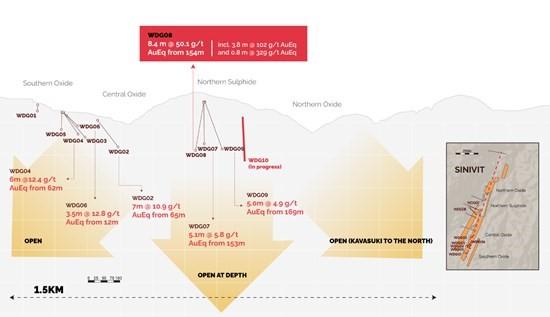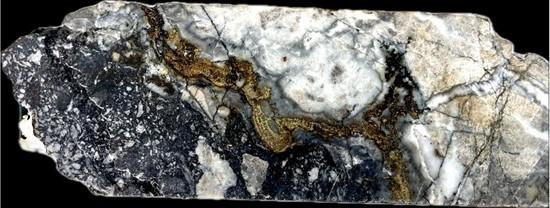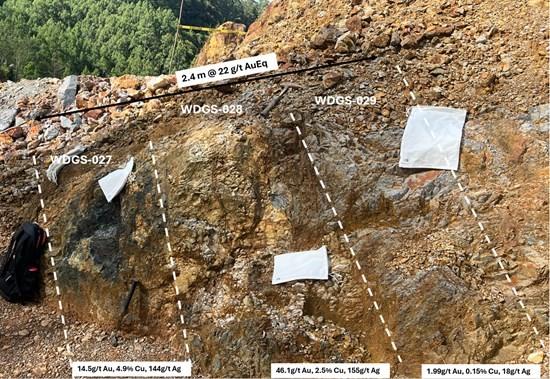
0.8m @ 127 g/t AuEq in Surface Sampling and 5.0m @ 4.9 g/t AuEq in Drilling at Great Pacific Gold’s Wild Dog Project
![]()
Great Pacific Gold Corp. (TSX-V: GPAC) (OTCQX: GPGCF) (FSE: V3H) announces results from its expanded Phase 1 diamond drill program at its flagship Wild Dog Project, located on the island of New Britain, East New Britain Province, Papua New Guinea.
Key Highlights:
- Sampling of Exposed Vein Structures in Southern Oxide Area:
- 0.8 m @ 127 g/t AuEq from Main Vein sample WDGS-036 (122 g/t Au, 2.7% Cu, 88 g/t Ag)
- 2.4 m @ 22 g/t AuEq from Main Vein sample WDGS-027, 028, 029 (17.2 g/t Au, 2.3% Cu, 94 g/t Ag).
- Hole WDG-09 intercepted:
- 5.0 m @ 4.91 g/t AuEq from 169m (4.49 g/t Au, 0.21% Cu, 7.6 g/t Ag);
- Including: 2.0m @ 11.1 g/t AuEq from 169m (10.3 g/t Au, 0.41% Cu, 15.0 g/t Ag), and
- 2.6 m @ 6.62 g/t AuEq from 182.4m (2.74 g/t Au, 2.16% Cu, 42.96 g/t Ag).
- Second drill rig being mobilized: additional camp capacity is being developed to support the second rig at the Wild Dog site.
- LiDAR survey completed with results due October 6, 2025: High-precision fixed-wing airborne LiDAR and large-format imagery survey covering 187 km² across the Wild Dog district has been completed. The program will generate a Digital Terrain Model with sub-10 cm vertical accuracy, providing critical topographic control for geological modelling, drill planning, and infrastructure layout. The dataset will also support structural mapping and refine target definition across the broader Wild Dog corridor.
“Hole 9 was drilled approximately 30m to the north of hole 7, into an area where we had very little information,” stated Greg McCunn, CEO. “The intercept with the main Wild Dog structure supports the continuity of the system. With hole 10 also intercepting the main structure a further 70 meters north (assays pending), we are increasingly confident in our geological model that is supporting the Phase 1 drill program. With the second rig being mobilized, we are expecting to accelerate the completion of the planned 28 holes at Sinivit which are providing valuable information on vein orientation allowing us to start testing the system at depth. Mobile MT geophysics has highlighted significant potential at depth and along strike to both the North and South from Sinivit on the large-scale epithermal Wild Dog corridor.”
“The recent mapping and sampling campaign in the historic Southern Oxide pit area was undertaken to support modeling of the vein structures intersected in drill holes WDG-03, 04, 05 and 06 earlier in the Phase 1 program. The high-grade results in the veins exposed in the historic pit confirm the high-grade nature of the system.”
Wild Dog Phase 1 Diamond Drill Program
The Phase 1 program commenced in May 2025 and is designed to test the Sinivit target, a 1.5 km strike length within the 15 km Wild Dog epithermal vein structural corridor (Figure 1). The high-grade nature of the system has already been confirmed by multiple strong intercepts.
In addition, recent processing of MobileMT geophysical data has highlighted the exceptional scale of the epithermal system and the potential for a major porphyry copper-gold system adjacent to the veins – a setting analogous to the Wafi-Golpu deposit in PNG (mineralization at Wafi-Golpu is not necessarily indicative of mineralization at Wild Dog).
The expanded program now totals 28 diamond drill holes and is expected to continue into early 2026. Drilling to date has only tested a small portion of the mineralized corridor, which remains open to the north, south, and at depth. A second drill rig is in the process of being mobilized to site.

Figure 1: Long section through the Sinivit target area showing drilling completed to-date with key intervals.
Since commencing in May 2025, GPAC has completed ten drill holes at Sinivit. Hole WDG-10 experienced poor core recovery within the main Wild Dog structure, which was intercepted from 173 meters to 185 meters. Although samples have been collected and submitted for assay, a decision was made to re-drill the hole to ensure full recovery of the target zone, and WDG-10A is well underway and currently at 165 meters depth. Details of the drilling are shown in Table 1 with key assay results received to-date are shown in Table 2.
Results
Table 1: Wild Dog Drill Hole Details (PNG94 UTM coordinates).
| Hole ID | Easting | Northing | RL | Dip | Azi | Max Depth (m) |
Status |
| WDG-01 | 394358.3 | 9488853.5 | 945 | -50 | 115 | 40.1 | Abandoned |
| WDG-02 | 394426.0 | 9489024.2 | 900 | -53 | 050 | 124.6 | Completed |
| WDG-03 | 394384.9 | 9488926.5 | 924 | -50 | 053 | 127.6 | Completed |
| WDG-04 | 394384.8 | 9488926.5 | 924 | -50 | 75 | 120.6 | Completed |
| WDG-05 | 394384.8 | 9488926.5 | 924 | -50 | 116 | 105.9 | Completed |
| WDG-06 | 394428.6 | 9488923.1 | 911 | -50 | 352 | 69.0 | Completed |
| WDG-07 | 394457.5 | 9489375 | 993 | -61 | 114 | 201.3 | Completed |
| WDG-08 | 394455.5 | 9489373.0 | 993 | -57 | 127 | 224 | Completed |
| WDG-09 | 394459.5 | 9489374.0 | 993 | -58 | 85 | 203 | Completed |
| WDG-10 | 394475.1 | 9489484 | 965 | -58 | 114 | 220 | Completed |
| WDG-10A | 394475.1 | 9489484 | 965 | -57 | 114 | TBD | In progress |
Table 2: Wild Dog Drill Hole Key Assay Results (WDG-02 to WDG-08 results previously announced).
| Hole ID | From (m) |
To (m) |
Interval1 (m) | Gold (g/t) |
Silver (g/t) |
Copper (%) | Gold Eq.2 (g/t) |
| WDG-02 | 65.0 | 72.0 | 7.0 | 5.49 | 68.84 | 2.96 | 10.91 |
| including | 65.0 | 67.0 | 2.0 | 10.73 | 114.64 | 2.23 | 15.53 |
| WDG-03 | 102.0 | 104.3 | 2.3 | 1.68 | 6.48 | 0.12 | 1.94 |
| including | 103.55 | 104.3 | 0.75 | 4.05 | 10.90 | 0.17 | 4.45 |
| WDG-04 | 62.0 | 68.0 | 6.0 | 8.31 | 27.56 | 2.37 | 12.35 |
| including | 64.0 | 68.0 | 4.0 | 12.25 | 36.76 | 1.71 | 15.35 |
| including | 64.0 | 66.4 | 2.4 | 19.76 | 57.75 | 2.59 | 24.48 |
| WDG-05 | 72.0 | 77.0 | 5.0 | 1.28 | 11.71 | 0.25 | 1.80 |
| including | 72.0 | 75.0 | 3.0 | 1.91 | 15.36 | 0.31 | 2.58 |
| WDG-06 | 12.0 | 15.5 | 3.5 | 4.61 | 48.36 | 4.86 | 12.79 |
| including | 13.7 | 14.3 | 0.6 | 7.44 | 73.40 | 10.42 | 24.61 |
| WDG-07 | 153.0 | 163.0 | 10.0 | 2.99 | 10.92 | 0.32 | 3.61 |
| including | 153 | 158.1 | 5.1 | 4.77 | 14.54 | 0.54 | 5.79 |
| WDG-07 | 172.0 | 173.2 | 1.2 | 7.30 | 93.5 | 1.14 | 10.17 |
| including | 172.5 | 173.2 | 0.7 | 12.00 | 178.0 | 1.94 | 17.10 |
| WDG-08 | 154 | 162.4 | 8.4 | 46.46 | 59.63 | 1.90 | 50.12 |
| including | 154 | 157.8 | 3.8 | 93.30 | 128.72 | 4.74 | 102.2 |
| including | 157 | 157.8 | 0.8 | 322.0 | 84.5 | 4.26 | 329.65 |
| WDG-08 | 180 | 188 | 8 | 1.95 | 4.19 | 0.13 | 2.20 |
| including | 180 | 184 | 4 | 3.32 | 3.71 | 0.16 | 3.62 |
| WDG-09 | 169 | 174 | 5 | 4.49 | 7.60 | 0.21 | 4.91 |
| including | 169 | 171 | 2 | 10.31 | 15.0 | 0.41 | 11.13 |
| WDG-09 | 182.4 | 185.0 | 2.6 | 2.74 | 42.96 | 2.16 | 6.62 |
| including | 182.8 | 184.3 | 1.5 | 4.17 | 41.87 | 1.89 | 7.61 |
Notes:
- Drill highlights presented above are core lengths (true widths are not known at this time).
- Gold equivalent (AuEq) exploration results are calculated using longer-term commodity prices with a copper price of US$4.50/lb, a silver price of US$27.50/oz and a gold price of US$2,000/oz. No metallurgical testing has been carried out on Wild Dog mineralized samples. For AuEq calculations, recovery assumptions of Au 92.6%, Ag 78.0%, and Cu 94.0% were used based on K92 Mining’s stated recovery results in an Updated Definitive Feasibility Study for the Kainantu mine.
WDG-09 Summary
Hole WDG-09, drilled approximately 30 metres north of WDG-07, successfully intersected the main Wild Dog structure and returned 5.0 metres at 4.9 g/t AuEq from 169 metres, including 2.0 metres at 11.1 g/t AuEq. A second mineralised zone was encountered between 182.4 and 185.0 metres, averaging 2.6 metres at 6.6 g/t AuEq, including 1.5 metres at 7.6 g/t AuEq. This deeper interval contained exceptionally high copper values, with assays up to 5.5% Cu accompanied by elevated silver grades, reflecting the presence of bornite and chalcopyrite observed in core. The mineralisation is hosted within banded quartz-silica breccias and vein material, consistent with the high-sulphidation epithermal style recognised at Sinivit. These results confirm continuity of the Wild Dog system to the north, while also highlighting the potential zonation within the structure, where in this case a high-grade gold shoot is underlain by copper-silver rich sulphide domains. Importantly, the combination of strong Au, Cu, and Ag values supports the potential for vertically extensive mineralized shoots, strengthening the broader geological model and demonstrating the prospectivity of the Wild Dog vein corridor at depth.

Figure 2: Drill core from Hole WDG-09 (182.5 m) illustrating a quartz-silica breccia cut by a colloform banded sulphide vein. Massive chalcopyrite with associated bornite occurs as coarse infill along the vein margins and in open spaces, overprinting black silica breccia clasts. This mineral assemblage is characteristic of a high-sulphidation epithermal system and corresponds to assays returning multi-percent copper and elevated Au-Ag values from this interval.

Figure 2: Drill core from Hole WDG-09 (183.15 m) displaying colloform banded quartz-silica veining with coarse-grained sulphide mineralisation. Bornite occurs as blebs and bands with associated chalcopyrite along quartz vein margins and in the matrix.
Southern Pit Rock Chip Sampling
On September 10, 2025, GPAC geologists undertook a sampling and mapping campaign in the historic Southern Oxide Pit area. Wild Dog main Vein structures which were intercepted in drill holes WDG-03, 04, 05 and 06 outcrop in the historic pit area and sampling and mapping was undertaken to support modelling of the veins in the area.
In total, seventeen samples were collected. In the west wall of the historic South Oxide Pit, the main vein can be observed (Figure 3).

Figure 3: Photo of sample location for WDGS-036 which returned 0.8 meters at 127 g/t AuEq. The main vein in this area shows black silica, grey-white quartz with chalcocite, bornite and chrysocolla.
In the east wall of the historic South Oxide Pit, the main vein can also be observed (Figure 4).

Figure 4: Photo of outcrop of main vein location for samples WDGS-027, 028, and 029 which returned 2.4 meters at 22 g/t AuEq. Black silica with stage 2 quartz veining is evident in sample WDGS-027 with predominantly white quartz with chalcopyrite in WDGS-028.
Qualified Person
The technical content of this news release has been reviewed, verified and approved by Callum Spink, the Company’s Vice President, Exploration, who is a member of the Australian Institute of Geoscientists, MAIG, and a Qualified Person as defined by National Instrument NI 43-101 Standards of Disclosure for Mineral Projects. Mr. Spink is responsible for the technical content of this news release. Mr. Spink is not independent of the Company.
Quality Assurance / Quality Control
The Company adheres to industry best practices for Quality Assurance and Quality Control. Drill core samples were submitted to Intertek Minerals Ltd. in Lae, Papua New Guinea, an ISO 9001-certified laboratory. Samples were securely sealed in poly-weave bags with single-use tie-locks to maintain chain of custody. Analytical testing was completed using fire assay with additional multi-element MS48 analysis underway.
Diamond drill hole WDG-02 was drilled using a combination of HQ and PQ diameter core, while the remainder of the holes were drilled with PQ. Certified reference materials (standards) and blanks were inserted into the sample stream in accordance with industry-standard protocols. Blanks were routinely inserted after high-grade intervals, and certified standards were included at a frequency of at least 5%. All assay batches received to date have passed QAQC review and fall within acceptable tolerance limits. Core recoveries for all holes were within acceptable ranges, with sampling procedures carefully managed in intervals where ground conditions were variable or fragile.
Preliminary copper assays are reported from assay results generated by aqua regia digestion and atomic absorption (AA) copper determination. The results are updated with assay results using MS48 (metallic screen fire assay) with four-acid digestion and atomic adsorption spectroscopy for copper determination.
About Great Pacific Gold
Great Pacific Gold’s vision is to become the leading gold-copper development company in Papua New Guinea. The Company has a portfolio of exploration-stage projects in PNG, as follows:
- Wild Dog Project: the Company’s flagship project is located in the East New Britain province of PNG. The project consists of a large-scale epithermal target, the Wild Dog structural corridor, stretching 15km in strike length and potentially over 1,000 meters deep based on a recent MobileMT geophysics survey. The survey also highlighted the Magiabe porphyry target, adjacent to the epithermal target and potentially 1,000 meters in diameter and over 2,000 meters deep. Drilling of the epithermal structure on the Sinivit target has yielded high-grade results, including WDG-02 which intercepted 7.0 meters at 11.2 g/t AuEq from 65 meters. The current drilling program will extend into 2026 with 5,000 meters planned over 28 holes.
- Kesar Project: located in the Eastern Highlands province of PNG and contiguous with the mine tenements of K92 Mining Inc. (“K92”), the Kesar Project is a greenfield exploration project with several high-priority targets in close proximity to the property boundary with K92. Multiple epithermal veins at Kesar are on strike and have the same orientation as key K92 deposits, such as Kora. Exploration work to date by the Company at the Kesar Project has shown that these veins have high grades of gold present in outcrop and very elevated gold in soil grades, coincident with aeromagnetic highs. The Company conducted a diamond drill program on key target areas at the Kesar Project from November 2024 to May 2025 and are working on developing a follow-up Phase 2 program for Q1 2026.
- Arau Project: also located in the Eastern Highlands province of PNG, the Arau Project is south of and contiguous to the mine tenements of K92. Arau contains the highly prospective Mt. Victor exploration target with potential for a high sulphidation epithermal gold-base metal deposit. A Phase 1 Reverse Circulation drilling program was completed at Mt. Victor in August 2024, with encouraging results. The Arau Project includes the Elandora licence, which also contains various epithermal and copper-gold porphyry targets.
The Company also holds the Tinga Valley Project in PNG.
MORE or "UNCATEGORIZED"
Kuya Silver Confirms High-Grade Silver-Gold Vein Mineralization at Umm-Hadid with Initial Drill Results up to 1483.9 g/t AgEq over 2 Metres
Kuya Silver Corporation (CSE: KUYA) (OTCQB: KUYAF) (FSE: 6MR1) is... READ MORE
First Phosphate Closes Final Tranche of Oversubscribed Private Placement
First Phosphate Corp. (CSE: PHOS) (OTCQX: FRSPF) (FSE: KD0) is... READ MORE
GFG Receives Final Payment from the Sale of its Rattlesnake Hills Gold Project
GFG Resources Inc. (TSX-V: GFG) (OTCQB: GFGSF) announces that i... READ MORE
Goliath Receives $1,730,882 Through Warrant Exercises, Inclusive Of Crescat Capital A Longtime Strategic And Cornerstone Shareholder
Goliath Resources Limited (TSX-V: GOT) (OTCQB: GOTRF) (FSE: B4IF)... READ MORE
Robex Pours First Gold at Kiniéro on Schedule and Budget
Highlights: Gold bar weighing 2.64 kilograms (85 oz) poured in th... READ MORE












